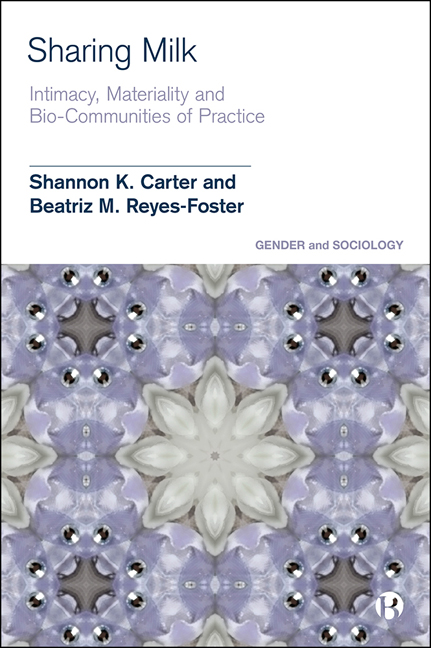Book contents
- Frontmatter
- Dedication
- Contents
- List of Figures and Tables
- Notes on the Authors
- Acknowledgements
- Preface
- 1 Introduction: Sharing Milk
- 2 Theorizing Milk Sharing
- 3 Entering Bio-Communities of Practice
- 4 Milk-Sharing Practices
- 5 The Milk-Sharing Network
- 6 Conclusion
- Notes
- Appendix A Survey Participant Demographics
- Appendix B Interview Participant Demographics
- References
- Index
5 - The Milk-Sharing Network
Published online by Cambridge University Press: 10 March 2021
- Frontmatter
- Dedication
- Contents
- List of Figures and Tables
- Notes on the Authors
- Acknowledgements
- Preface
- 1 Introduction: Sharing Milk
- 2 Theorizing Milk Sharing
- 3 Entering Bio-Communities of Practice
- 4 Milk-Sharing Practices
- 5 The Milk-Sharing Network
- 6 Conclusion
- Notes
- Appendix A Survey Participant Demographics
- Appendix B Interview Participant Demographics
- References
- Index
Summary
The Educated Mama, a closed Facebook group devoted to natural parenting and informed choice, is a busy place. With over 10,000 members, new posts devoted to questions of child development, baby sleep and cloth diapering appear constantly. Breastfeeding struggles are a frequent topic of conversation, and in these contexts milk sharing often comes up. In an age of visual storytelling and memes, one of the most visually striking posts observed are those of collages lovingly created by mothers whose babies have benefitted from donor milk. These visual stories present a narrative of interconnectedness, of babies connected to unrelated mothers and each other by the milk they consume. In this chapter, we explore the nature of these connections.
Foundational context
The first thing I (Beatriz) did when I found out I was pregnant with my oldest son was go on the internet. I spent hours reading up on pregnancy on websites like BabyCenter and The Bump. Before I was even out of my first trimester, I had devoted an inordinate amount of time to reading reviews for car seats, stroller, and bassinettes. I marvelled at the biological process of lactation and eagerly repeated to myself the mantra ‘breast is best’. Home birth wasn't right for me, but when I saw that having a midwife-attended hospital birth reduced the chances of C-sections, I immediately decided that was the care I would seek – and then spent hours researching local nurse-midwives. Once I found a provider, I attended my appointments and read the pregnancy magazines in the lobby. I learned about attachment parenting – a style of parenting that encourages secure attachment through constant bonding and contact between baby and caretaker (Granju and Kennedy 1999; Sears and Sears 2001; Faircloth 2013) – and decided that was what I wanted to do. I saw people wearing their babies in little blue carriers and knew I wanted one too. As the months progressed, I was exposed to a series of discourses and objects that shaped my desires for the baby I was soon to have. Some of these ideas had to do with philosophies of child raising, but others were products I needed to purchase. Pregnancy was both about my changing identity as a mother but also as a consumer (Afflerback et al 2013, 2014; Han 2013; O’Donohoe et al 2013; Kehily and Martens 2014; Tiidenberg and Baym 2017).
- Type
- Chapter
- Information
- Sharing MilkIntimacy, Materiality and Bio-Communities of Practice, pp. 135 - 164Publisher: Bristol University PressPrint publication year: 2020



